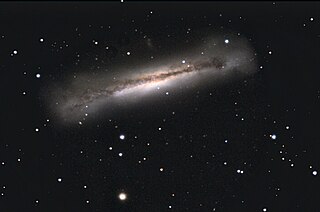
NGC 3628, also known as the Hamburger Galaxy or Sarah's Galaxy, is an unbarred spiral galaxy about 35 million light-years away in the constellation Leo. It was discovered by William Herschel in 1784. It has an approximately 300,000 light-years long tidal tail. Along with M65 and M66, NGC 3628 forms the Leo Triplet, a small group of galaxies. Its most conspicuous feature is the broad and obscuring band of dust located along the outer edge of its spiral arms, effectively transecting the galaxy to the view from Earth.

Abell 400 is a galaxy cluster which contains the galaxy NGC 1128 with two supermassive black holes spiraling towards merger.
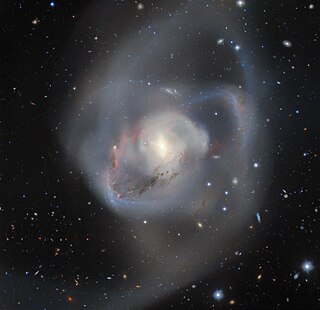
NGC 7727 is a peculiar galaxy in the constellation Aquarius. It harbors two galactic nuclei, each containing a supermassive black hole, separated 1,600 light years apart.
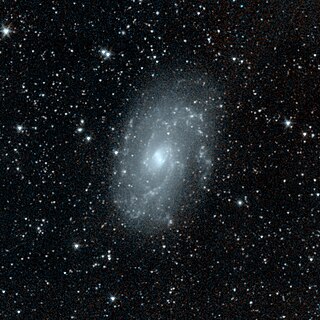
NGC 4145 is a barred spiral galaxy located in the Ursa Major galaxy cluster, 68 million light years from the Earth. The galaxy has little star formation, except on its outer edges. Due to the loss of energy that occurs without star formation, some astronomers predict that the galaxy will degenerate into a lenticular galaxy in the near future. However, the galaxy's interaction with NGC 4151 may "maintain [its] star formation".

NGC 1398 is an isolated barred spiral galaxy exhibiting a double ring structure. It is located 65 million light years from the Earth, in the constellation of Fornax. The galaxy, with a diameter of 135,000 light years, is bigger than the Milky Way. Over 100 billion stars are in the galaxy. It was first discovered by Friedrich Winnecke of Karlsruhe, Germany, on 17 December 1868, while he was searching for comets.
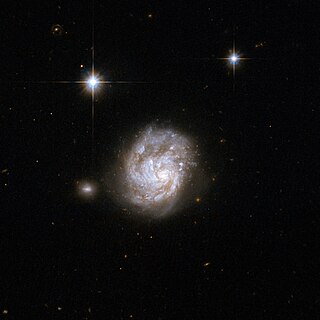
NGC 695 is a spiral galaxy located 450 million light years from the Earth, in the constellation of Aries. It has been described as an abnormal galaxy, and has the appearance of "a revolving tornado". Its arms are not tightly held together, and it is interacting with another small astronomical object. Despite its distance of nearly 0.5 billion lightyears, the galaxy's extremely luminous starburst disk, bright IR and UV emissions earned it a spot in the NGC catalogue. VLASS 1.2 survey images indicate the presence of extended radio emission in the core of the galaxy- indicative of either an active SMBH, nuclear starburst, or both.
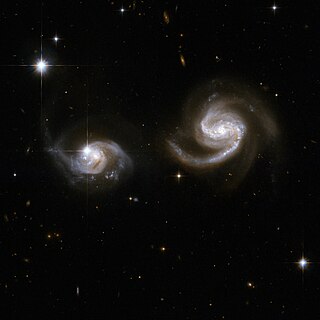
NGC 6786 is an interacting spiral galaxy 350 million light years from the Earth, in the constellation of Draco. NGC 6786 is currently interacting with LEDA 62867, and, being the larger galaxy, it is likely that NGC 6786 will absorb LEDA 62867 in the future. Both galaxies appear to be undergoing a starburst, a phenomenon commonly seen among interacting and merging galaxies.

NGC 1592 is an irregular galaxy in the constellation Eridanus. It is about 20,000 light-years across. It has not been studied in detail, as it is at 27 degrees south, making it not visible below 63 degrees north in a flat area, and about 50 degrees north in a hilly area. It was discovered in 1835 by John Herschel.

NGC 428 is a barred spiral galaxy in the constellation of Cetus, with its spiral structure distorted and warped, possibly the result of the collision of two galaxies. There appears to be a substantial amount of star formation occurring within NGC 428 and it lacks well defined arms — a telltale sign of a galaxy merger. In 2015 the Hubble Space Telescope made a close-up shot of the galaxy with its Advanced Camera for Surveys and its Wide Field and Planetary Camera 2. The structure of NGC 428 has been compared to NGC 5645.

NGC 7010 is a massive elliptical galaxy located about 370 million light-years from Earth in the constellation Aquarius. NGC 7010 was discovered by astronomer John Herschel on August 6, 1823, and was later listed by French astronomer Guillaume Bigourdan as IC 5082. It is host to a supermassive black hole with an estimated mass of 4.7 × 108M☉.
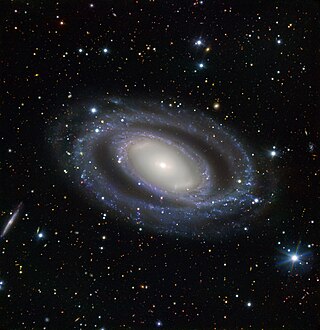
NGC 7098 is a doubled barred spiral galaxy located about 95 million light-years away from Earth in the constellation of Octans. NGC 7098 has an estimated diameter of 152,400 light-years. NGC 7098 was discovered by astronomer John Herschel on September 22, 1835.

NGC 4473 is an elliptical galaxy located about 50 million light-years away in the constellation of Coma Berenices. It was discovered by astronomer William Herschel on April 8, 1784. NGC 4473 has an inclination of about 71°. NGC 4473 is a member of a chain of galaxies called Markarian's Chain which is part of the larger Virgo Cluster of galaxies.

NGC 4429 is a lenticular galaxy located about 55 million light-years away in the constellation of Virgo. NGC 4429 is tilted at an inclination of about 75° which means that the galaxy is tilted almost edge-on as seen from Earth. NGC 4429 was discovered by astronomer William Herschel on March 15, 1784. The galaxy is a member of the Virgo Cluster.
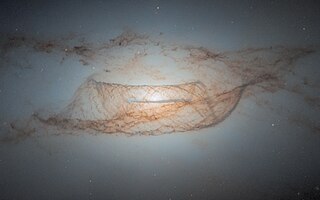
NGC 4753 is a lenticular galaxy located about 60 million light-years away in the constellation of Virgo. NGC 4753 was discovered by astronomer William Herschel on February 22, 1784. It is notable for having distinct dust lanes that surround its nucleus. It is a member of the NGC 4753 Group of galaxies, which is a member of the Virgo II Groups, a series of galaxies and galaxy clusters strung out from the southern edge of the Virgo Supercluster.
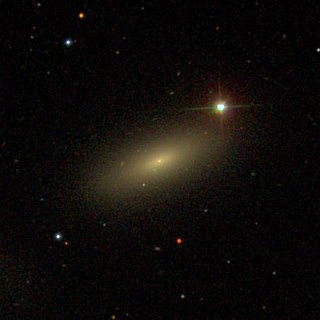
NGC 4436 is a lenticular or dwarf elliptical galaxy located about 60 million light-years away in the constellation of Virgo. NGC 4436 was discovered by astronomer William Herschel on April 17, 1784. The galaxy is a member of the Virgo Cluster.

NGC 2623(also known as ARP 243) is an interacting galaxy located around 263 million light-years away in the constellation Cancer. It was discovered on 19 January 1885 by French astronomer Édouard Jean-Marie Stephan.

NGC 4570 is an edge-on lenticular galaxy located about 57 million light-years away in the constellation Virgo. NGC 4570 was discovered by astronomer William Herschel on April 13, 1784 and is a member of the Virgo Cluster.

NGC 4660 is an elliptical galaxy located about 63 million light-years away in the constellation Virgo. The galaxy was discovered by astronomer William Herschel on March 15, 1784 and is a member of the Virgo Cluster.

NGC 3859 is a spiral galaxy located about 295 million light-years away in the constellation Leo. It was discovered by astronomer Édouard Stephan on March 23, 1884. The galaxy is a member of the Leo Cluster.

NGC 759 is an elliptical galaxy located 230 million light-years away in the constellation Andromeda. NGC 759 was discovered by astronomer by Heinrich d'Arrest on September 17, 1865. It is a member of Abell 262.




















